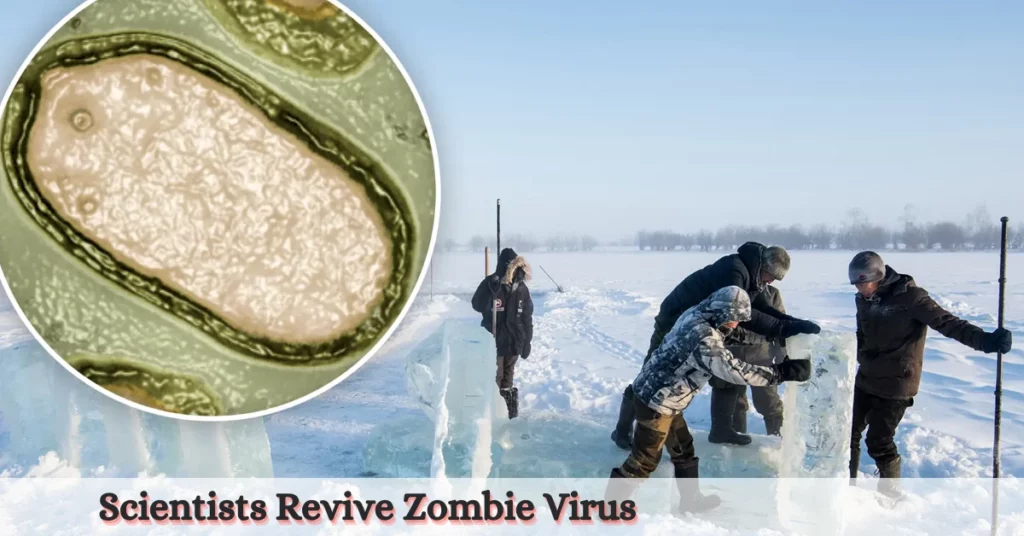French Scientists Revive Zombie Virus About 48,500 Years Old In Russia!
A 48,500-year-old “zombie virus” that was buried beneath a frozen lake in Russia has been awakened by French scientists.
According to the New York Post, French experts have raised concerns about another pandemic in response to the zombie virus’s resurgence.
The New York Post cites a famous study that has not yet undergone peer review. The report states that if an old, undiscovered virus were to resurface and cause diseases in plants, animals, or humans, “the scenario would be considerably more terrible.”
The permafrost, which is permanently frozen earth that covers a fifth of the Northern Hemisphere, is irrevocably thawing, according to the preliminary research. The troubling result of this has been the release of organic components frozen for up to a million years, including potentially dangerous pathogens.
The researchers note that some organic materials contain viruses that have been dormant since prehistoric times and revived cellular microorganisms (prokaryotes, unicellular eukaryotes).
The New York Post reports that scientists are investigating the reawakening of animals by reviving some of these supposedly “dead viruses” from the Siberian permafrost.
The oldest was Pandoravirus yedoma, 48,500 years old—a record for a frozen virus resuming its infectious state at such a late age. This surpasses the previous form set by the same researchers in 2013, who discovered a 30,000-year-old virus in Siberia.
According to Science Alert, the new strain is one of 13 viruses described in the study, and each had a distinct genome.
While the Pandoravirus was found in the intestines of a Siberian wolf, other viruses have been found in mammoth fur and a lake in Yukechi Alas, Yakutia, Russia.
After studying the live cultures, researchers found that all “zombie viruses” have the potential to be contagious and hence represent a “health concern.” They predict that as permafrost melts, long-dormant viruses will be released, like a microbial Captain America, causing new pandemics in the manner of the covid.
Therefore, they add, “it is legitimate to consider the possibility of old virus particles still being infectious and returning to the population due to the thawing of ancient permafrost layers.”
The organic material released by the thawing ice breaks down into carbon dioxide and methane, intensifying the greenhouse impact and hastening the melt. Sadly, this creates a vicious cycle.
According to the New York Post, there are probably still other hibernating viruses that have not yet been found. Therefore, the freshly awakened virus may represent the tip of the epidemiological iceberg.
More research is required to determine how contagious these unidentified viruses are when exposed to light, heat, oxygen, and other environmental factors.
How Dangerous Can The Zombie Virus Be To The General Public?
According to researchers, all “zombie viruses” can spread, making them a “health hazard” when studying live cultures. They predict that long-dormant viruses will continue to emerge like a microbial Captain America when permafrost melts, resulting in new pandemics like COVID-19.
Read more:
- Matthew Preziose, A Resident of Middletown, Is Missing In Hawaii After Being Swept Into The Ocean!
- Green Power Rangers Actor Jason David Frank Passes Away At The Age of 49!
Due to the thawing of historic permafrost layers, they continue, “it is legitimate to consider the probability of old virus particles still being infectious and returning to the population.” The thawing ice releases organic material that decomposes into carbon dioxide and methane, amplifying the greenhouse effect and speeding up the melt. Unfortunately, this starts a vicious circle.
The study concluded that unidentified viruses might be released following the future thawing of permafrost much older than 48,500 years. The report continued, “We believe our results with Acanthamoeba-infecting viruses can be generalized to many other DNA viruses capable of infecting humans or animals without the need to start on such a dangerous undertaking.”
“At this point, neither the length of time that these viruses may remain contagious after being exposed to environmental factors (UV light, oxygen, or heat) nor the likelihood that they will come into touch with and infect a suitable host during that time can be predicted.
